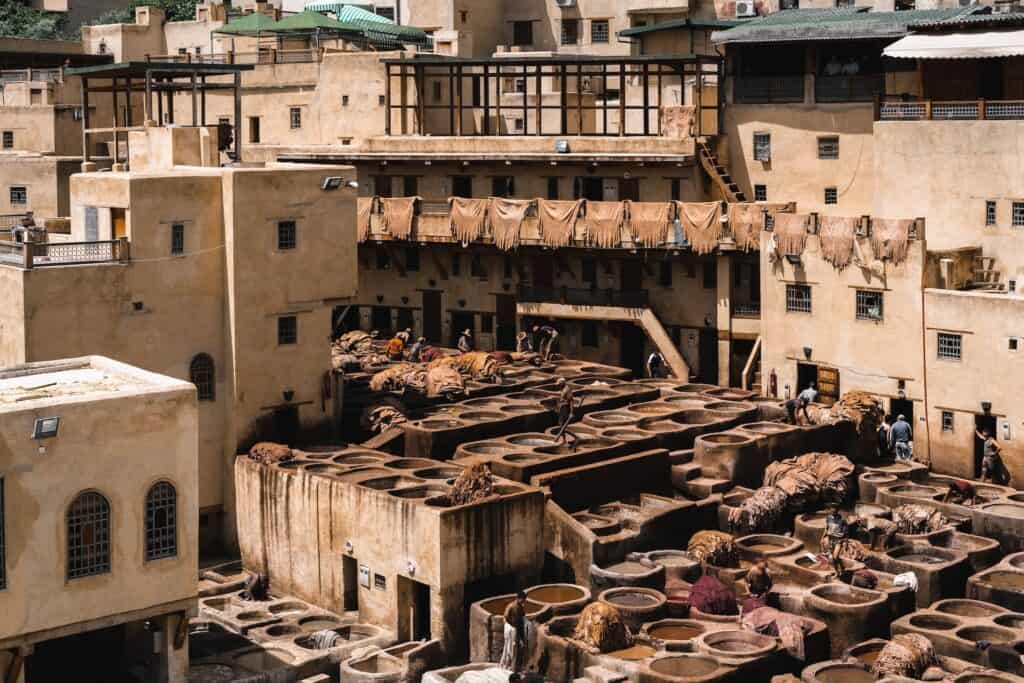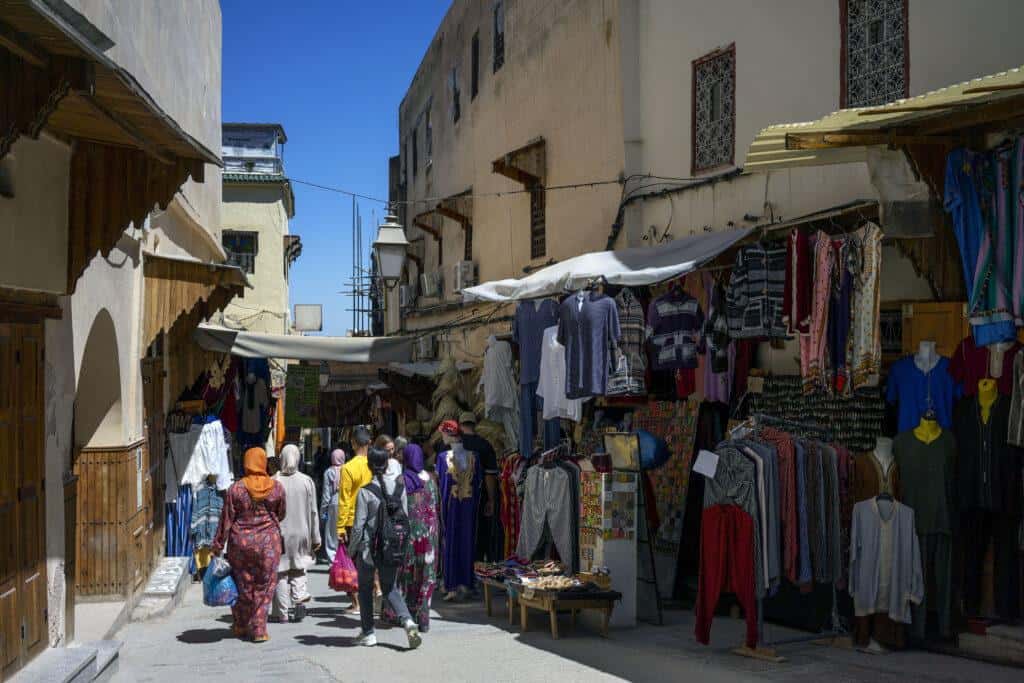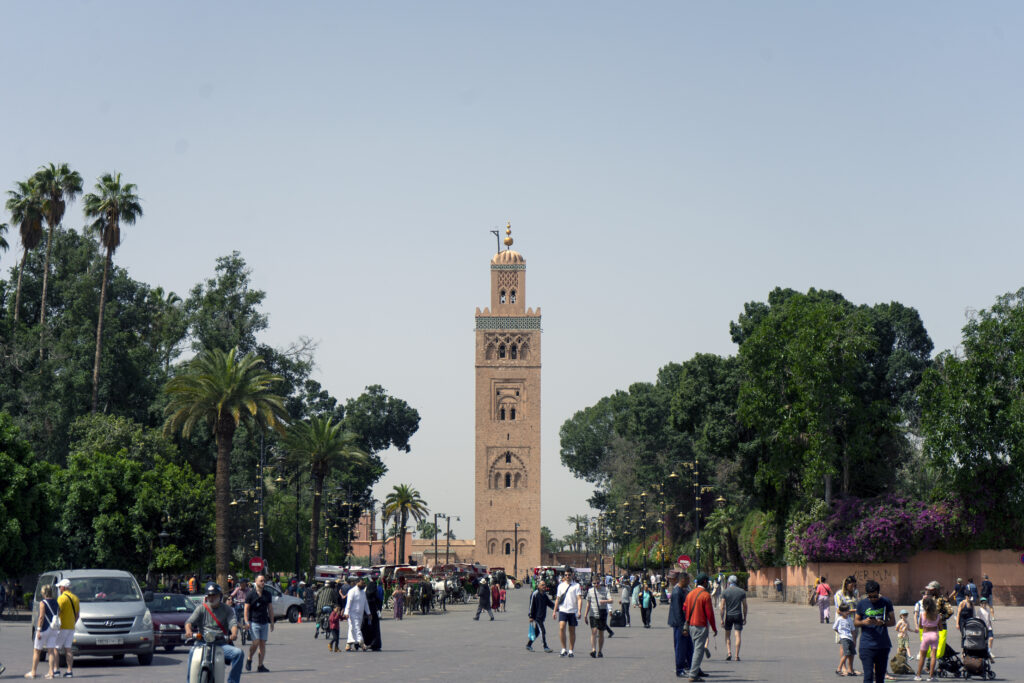Last Updated on June 19, 2024
Disclosure: This article includes affiliate links. This means that if you make a purchase through one of those links, I earn a small commission. Affiliate links cost you nothing to use, and keep Pina Travels reader-supported. Thank you!
The town of Bhalil is in the Middle Atlas region of Morocco. With a population of around 12,000 people, it’s small and quiet. Although you won’t find Bhalil on many Morocco itineraries, this town is well worth a visit.
Bhalil is made up of two parts: the new part of town, which began to be built in the 20th century, and the old part, which dates back to the 4th century. With such a long history, it’s no surprise that there are a few things that make the town unique.
Bhalil is most well known for its caves. Millions of years ago, the Atlantic Ocean carved caves out of limestone in the Bhalil region. For hundreds of years, locals have used these caves as homes and storage spaces, and today, as shops.
Visiting Bhalil gives you the chance to see some of these caves, and learn about what life in this Moroccan town is like. The best way to experience Bhalil is to book into one of the town’s homestays, like Dar KamalChaoui.
Read on to learn why you should add Bhalil to your Morocco itinerary, how to get there, where to stay, and things to do in Bhalil, Morocco.

Why Bhalil, Morocco is Worth Visiting
Set on the side of a hill northwest of Sefrou, the town of Bhalil is most known for its unique cave houses, which are found in the old part of the village. Visiting these caves gives you a glimpse into a way of life that has been practiced in Bhalil now for hundreds of years.
Aside from Bhalil’s caves, Bhalil is worth visiting to learn about its button-making industry, and to observe the local tradition of women wearing haik (a large piece of cotton, silk, or wool cloth worn as an outer garment in Morocco.)
Bhalil is included as one of the stops in several of the day trip tours that operate out of Fes. If you have limited time, this is a good option for visiting Bhalil. On this Sefrou and Bhalil Day Trip, you can see the town of Sefrou, known for its waterfalls, visit Bhalil’s caves, and learn about Berber life from locals.
If you have more time to spend, I recommend staying at least one night (or more!) in Bhalil. Spending more time gives you the opportunity to observe more, learn more, and develop a better understanding of local life. I spent a full 24 hours in Bhalil, and had such a good time, I wish I’d spent more.

Where to Stay in Bhalil
For years, Bhalil famously had only one guest house. That guest house is Dar KamalChaoui, where I stayed. Kamal, the owner of the guest house, told me that while he was the first one to offer accommodation in the town, a few other local people are following his lead. Now, Kamal says, there are two or three guest houses.
My stay in Dar KamalChaoui was absolutely perfect. Kamal and his wife Jalila welcomed me into their home like I was a life-long friend. When I arrived, they showed me straight to my room, and then met me on their home’s roof top to chat over a glass of fresh mint tea.
Kamal and Jalila have three guest rooms in their house. Each room has a comfy double bed and an ensuite bathroom with hot water. The rooms are beautifully decorated with local art and woodworked furniture.
When you stay at Dar KamalChaoui, all your meals are provided. This is important, because Bhalil doesn’t have many restaurants, and the ones that they do have, are more like cafes. Jalila prepared traditional Moroccan meals complete with desserts that she told us her mother had made.

How to Get to Bhalil, Morocco
Bhalil is about 27 kilometers (16 miles) from the city of Fes. There’s no bus from Fes to Bhalil, and so the easiest way to reach Bhalil is to rent a car or hire a private driver or taxi to take you.
Alternatively, you can take a local bus from Fes to Sefrou, which is just 6 kilometers from Bhalil. From Sefrou, you can take a shared taxi the rest of the way. The shared taxi should cost just a few dirhams.
I booked into Dar KamalChaoui for my stay in Bhalil. For a reasonable price, the owner of the guest house, Kamal, arranged my transfer from Fes to Bhalil, and then from Bhalil to the Fes train station for onward travel.
What to See in Bhalil
In Bhalil there are several mosques, schools, and a public bath. The town also has a market one day a week, and many shops that specialize in various goods, like garment making.
The best way to see Bhalil is by walking tour with a local guide. This is another benefit of staying with Dar KamalChaoui (or another guest house). Kamal was excited to take me and the others who were staying in his home on a guided walk around Bhalil.

The Cave Homes of Bhalil
Bhalil’s cave dwellings are its most well-known attraction. The town has more than 500 caves, which you wouldn’t even know are there because many of the caves blend into the town’s streets.
Some are individual cave homes, and others have been incorporated into houses. Kamal brought my group to one cave dwelling, just around the corner from the guest house. Kamal’s neighbor Kacem lives there, and he invited us in to take a look.
Kamal explained to us that cave dwellings vary in comfort. They do tend to be dark and damp, and for that reason, they’re considered a budget option. Kamal told us that many people in Bhalil rent cave dwellings temporarily.
Caves in Bhalil aren’t only used as homes. The majority of them are actually used as storage spaces and as shops.

Traditional Button Making
Bhalil is famous for its production of woven djellaba buttons. Djellaba is a long, loose-fitting, traditional robe that has a hood. Djellaba typically have buttons that run down the front of the garment. Some will have up to 100 buttons.
These buttons are hand-made using a needle and thread. It’s a tedious process that requires skill, and a really steady hand. In Bhalil, there’s a long tradition of djellaba button making. The buttons are made by local women, who learn the skill from their mothers and grandmothers.
For women in Bhalil, it’s a way to make money – but it’s also a social past-time. During my time in Bhalil, I often noticed groups of three or more women, sitting outside in the afternoon, making buttons while chatting together.
Ali Baba Shop
Nearby Dar KamalChaoui is a must-visit shop inside a long, old cave. Kamal brought us to this shop and introduced us to the owner, Latef Abdallaoui. Latef is an artist and carpenter, in fact, he made much of the furniture inside Kamal’s home.
But Latef’s other passion is collecting antiques. His 6th century cave shop, called Ali Baba Shop, is filled with interesting things that Latef has found in markets around Morocco. Latef was happy to show us things from around the shop.
When we walked into the cave, he right away went to his vinyl collection and selected something to play. We listened to Cyndi Lauper while he showed us a collection of old coins, and old stamps.
When you visit Ali Baba Shop, be sure to walk all the way in. The cave is slender, but very long. You’ll be surprised by how far back it goes!
You’ll also want to take a look at the paintings that are hung all around the entrance to the cave. They are beautiful scenes that are hand-painted by Latef. I bought one as something to bring home with me, and it’s hanging now on my apartment wall.

Daily Life in Bhalil
On a walking tour of Bhalil, you’ll get a sense of what life in the town is like. You’ll walk by women wearing beautiful haik, a large piece of cotton, silk, or wool cloth that’s worn as an outer garment in Morocco.
You’ll stop by shops selling fruits, vegetables, garments, and more. You’ll see some of Bhalil’s mosques, and you’ll stop by Bhalil’s hammam, which is a public bath house.
If you stay in Dar KamalChaoui, you’ll have your meals with Kamal and Jalila. Dinner with them was one of my favourite parts of my stay in Bhalil. I visited during Ramadan, and fasted all day, as were Kamal and Jalila.
When the sun had set, we all gathered at Kamal and Jalila’s dinner table and had a delicious meal of harira soup and tagine together. We chatted, shared stories, and laughed together.

Final Thoughts: My Experience in Bhalil
I’ve traveled to Morocco twice, visiting famous cities like Fes, Marrakech, Casablanca, and the Sahara Desert. As amazing as all these places are, visiting Bhalil was a special experience.
Bhalil is unlike Morocco’s more popular tourist destinations. The pros and cons of tourism have yet to change life in the town, and you can feel that when you’re there. You feel you’re getting a real glimpse into one part of Moroccan life. This is one of the greatest benefits of staying in a homestay versus hotel.
But my stay in Bhalil was most memorable because I was able to spend quality time with two wonderful people, Kamal and Jalila. It’s a place I’ll one day go back to, to visit new friends.
- Visit the website for Dar KamalChaoui to book your stay with Kamal and Jalila in Bhalil, Morocco.
Erin has been traveling for over a decade, both solo, and with her partner. She’s now traveled to countries across 6 continents, and has lived in 2 countries abroad. Erin also hosts the travel podcast, Curious Tourism, where she interviews travel industry thought leaders and experts about responsible tourism. Learn more about Erin, and get in touch with her, here.




